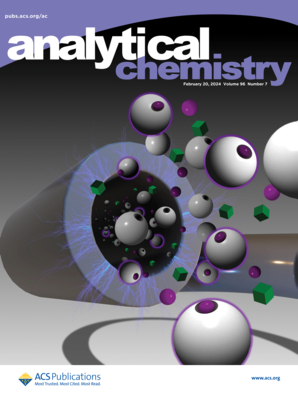Rapid MALDI-MS/MS-Based Profiling of Lipid A Species from Gram-Negative Bacteria Utilizing Trapped Ion Mobility Spectrometry and mzmine
IF 6.7
1区 化学
Q1 CHEMISTRY, ANALYTICAL
引用次数: 0
Abstract
Lipid A, a crucial component of lipopolysaccharides (LPS), plays a pivotal role in the pathogenesis of Gram-negative bacteria. Lipid A patterns are recognized by mammals and can induce immunostimulatory effects. However, the outcome of the interaction is highly dependent on the chemical composition of individual lipid A species. The diversity of potential fatty acyl and polar headgroup combinations in this complex saccharolipid presents a significant analytical challenge. Current mass spectrometry (MS)-based lipid A methods are focused on either direct matrix-assisted laser desorption/ionization (MALDI)-MS screening or comprehensive structural elucidation by tandem mass spectrometry (MS/MS) hyphenated with separation techniques. In this study, we developed an alternative workflow for rapid lipid A profiling covering the entire analysis pipeline from sample preparation to data analysis. This workflow is based on microextraction and subsequent MALDI-MS/MS analysis of uropathogenic Escherichia coli utilizing trapped ion mobility spectrometry (TIMS), followed by mzmine data processing. The additional TIMS dimension served for enhanced sensitivity, selectivity, and structural elucidation through mobility-resolved fragmentation via parallel accumulation-serial fragmentation (PASEF) in parallel reaction monitoring (prm)-mode. Furthermore, mzmine enabled automated MS/MS acquisition by adapting the spatial ion mobility-scheduled exhaustive fragmentation (SIMSEF) strategy for MALDI spot analysis. It also facilitated robust lipid A annotation through a newly developed extension of the rule-based lipid annotation module, allowing for the custom generation of lipid classes, including specific fragmentation rules. In this study, the first publication of lipid A species’ collision cross section (CCS) values is reported, which will enhance high-confidence lipid A annotation in future studies.

求助全文
约1分钟内获得全文
求助全文
来源期刊

Analytical Chemistry
化学-分析化学
CiteScore
12.10
自引率
12.20%
发文量
1949
审稿时长
1.4 months
期刊介绍:
Analytical Chemistry, a peer-reviewed research journal, focuses on disseminating new and original knowledge across all branches of analytical chemistry. Fundamental articles may explore general principles of chemical measurement science and need not directly address existing or potential analytical methodology. They can be entirely theoretical or report experimental results. Contributions may cover various phases of analytical operations, including sampling, bioanalysis, electrochemistry, mass spectrometry, microscale and nanoscale systems, environmental analysis, separations, spectroscopy, chemical reactions and selectivity, instrumentation, imaging, surface analysis, and data processing. Papers discussing known analytical methods should present a significant, original application of the method, a notable improvement, or results on an important analyte.
 求助内容:
求助内容: 应助结果提醒方式:
应助结果提醒方式:


